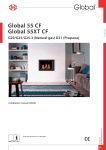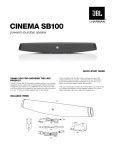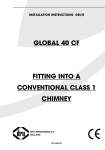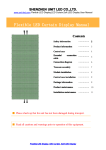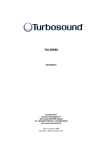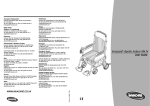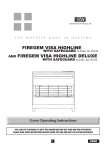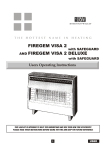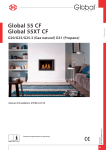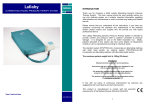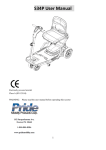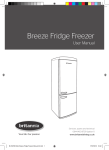Download Installation manual - Dru site for the trade
Transcript
INSTALLATION INSTRUCTIONS GB/IE Global 55 CF Global 55XT CF Fitting into a Conventional Class 1 Chimney DRU VERWARMING B.V. HOLLAND 957.771.00 CONTENTS Site: 3 Important 3 Foreword 4 Instructions for installation 4 Ventilation 4 Chimney and Flue System 4 Requirements 5Checking the Class 1 Chimney’s Performance Prior to Building the Builders Opening 5 Builders Opening Requirements 6 Preparing the Appliance for Installation into the Builders Opening 6 Using a Flue Liner 7 Fitting into a Conventional Class1 Chimney 7 Spillage Test 8 Figures 2 Instructions FOR INSTALLATION Foreword •T hese installation instructions are supplementary to the Installation Manual and User Manual. Dear Customer, In this booklet you will find instructions for the Installation of the appliance in a builder’s opening/fireplace connected to an existing chimney (class 1 chimney). Please read the Installation manual and these Instructions carefully to familiarize you with the Appliance. If you require any further support, please do not hesitate to contact your supplier. Gas Safety Regulations (for Installation and Use) 1998. In your own interest and that of Safety, it is Law that all Gas Appliances are Installed by Competent Persons in Accordance with the above Regulations. Failure to do so could result in prosecution. CORGI-The Council of Registered Gas Installers, whose Members are Identified by the CORGI Emblem are all required to work to these Recognised Regulations. The Installation must also be in accordance with all relevant parts of the Local and National Building Regulations where appropriate, the Building Regulations (Scotland Consolidation) issued by the Scottish Development Department, and all applicable requirements of the following British Standards and Codes of Practice. -B S 6891,Installation of Gas Pipe work - BS 5440, Parts 1 & 2 Installation of Flues and Ventilation - BS 1251, Open Fire Place Components - BS 715, Metal Flue Pipe for Gas Appliances - BS 6461, Part 1 Installation of Chimneys and Flues. - BS 7977-1, Specification for safety and rational use of energy of domestic gas appliances. Radiant/convectors 3 Fitting into a Conventional Class1 Chimney E n g l i s h Important Instructions FOR INSTALLATION INSTRUCTIONS FOR INSTALLATION •T he chimney should firstly be professionally swept before installing the appliance. • The chimney should be fitted with an effective chimney cowl, to ensure a good draught in the chimney to help safe guard against the effects of Down Draught and prevent Birds falling down the Chimney. The type of chimney cowl and the position of the opening must meet any applicable local standards, to ensure it works properly. • If the fire is installed in an existing chimney with a chimney kit, there may be a slight loss in heat input. Caution -T his fire is fitted with an Oxygen Sensing Pilot that will cut the fire off if the fire is not working Safely. This normally indicates a Chimney, Flue or Ventilation Problem. If this problem is experienced with the fire seek expert advice. - If this fire cuts off within 2 minutes of being lit it is quite likely that the flue or Chimney is Blocked. Ventilation The Global 55 CF and Global 55 XT CF is a open-flued appliances. As a result, the room in which the appliance will be placed has to be ventilated sufficiently. The ventilation must be in accordance with the relevant Regulations. Requirements The design of this fire is such that the appliance can be completely built-in first, into a Builders Opening / Fireplace (of non-combustible and heat-resistant material) and the flue connection can be done afterwards. Caution - Do not install the appliance in a bathroom or room that contains a bath or shower; - Always install the appliance into a non-combustible and heat-resistant wall; - Place the appliance on supports made of non combustible and heatresistant material; - Do not cover the appliance and/or do not wrap it in an insulation blanket or any other material; - Do not make any changes to the appliance; Chimney and Flue System The Fire can be installed into the following: - A traditional Class One 7” by 7” chimney with a minimum effective height of at least 3 meters. If the Chimney has been previously used, it must be swept. The debris shield shall be assembled. - A chimney lined with a 100mm liner with a minimum effective height of 3 meters. The liner must be connected directly to the spigot on the fire and terminate at the top of the chimney. 4 Instructions FOR INSTALLATION (Global 55XT CF) high and between 570mm and 590mm wide. •T he builders opening should be at least 330 mm deep. • Construct the Builders Opening accurately ensuring it is square and level to the front face of the Opening. The front face around the Builders Opening must be flat for at least 50mm to ensure the foam seal fitted to flanges of the convection box forms a seal against the opening. •D etermine the location of the appliance; see fig. 1 for the dimensions of the builder’s opening. • Determine the construction height of the appliance. • Provide a gas connection at the location. For details, see the Installation manual. Checking the Class 1 Chimney’s Performance Prior to Building the Builders Opening • Apply a smoke pellet to the base of the chimney. If the smoke is drawn into the chimney, continue and build the builders opening. If there is little to no flow into the chimney, preheat the chimney and repeat the smoke pellet test. • If there is still no flow, Seek Expert Advise as the chimney may need attention and it may be necessary to use a flue liner with the Chimney. • Check if the ventilation of the room is sufficient. Caution The convection box must be Fully Sealed to the Front of the Builders Opening. Failure to do so will Result in a Spillage Problem. • It is necessary and good practice to fit a Lintel at the top of the Builders Opening to support the brick work, if in doubt always contact a qualified Builder. • Where the Builders Opening already exists and is much larger than required the front opening must be reduced to the sizes shown above with non-combustible and heat-resistant materials. • The base of the opening must be level with the bottom of the opening, be flat and square with the front of the opening. • Where the fire is to be installed into a wall where wall paper is being considered as a wall covering it is recommended that non-combustible and heat-resistant slips such as slate or Builders Opening Requirements (fig. 1) • To build the appliance into the fireplace, a rectangular hole or Builders Opening must be made that is between 520mm and 530mm (Global 55 CF) or 695mm and 705mm 5 Fitting into a Conventional Class1 Chimney E n g l i s h -M ake sure that combustible objects and/or materials have a distance from the appliance of at least 500 mm. Instructions FOR INSTALLATION • • • • marble are fixed and sealed around the builders opening. See also the installation manuel. This will help to reduce wall discolouration. Blown vinyl wall paper or coverings must not be used. If you have newly cemented/ plastered the chimney or have had to carry out any other reconstructions /renovations work, you are advised to wait at least 6 weeks before fitting/ lighting the fire, to allow for the walls, floor and ceiling to dry out completely, otherwise cracking may occur. Cracking of the plaster will occur if not dried out properly. •A ttach the appliance with the screws through the holes in the flanges of the appliance. • With the flue liner already fitted in the chimney, fit the appliance, pull the liner through the hole in the top of the appliance and secure/seal it to the flue spigot (see fig. 3) • Screw the flue spigot back in position using the self-tapping screws. Caution The sealing surfaces of the spigot must be free of debris. • Screw the cover plate back in position using the self-tapping screws. • Connect the appliance according the installation manual. Caution Do not ignite the appliance until it is fully installed. • Replace the glass pane after installing the wood set according the installation manual. • Continue by testing the spillage of the appliance as described below in paragraph ‘Spillage Test’. Preparing the appliance for Installation into the Builders Opening • Remove the glass pane (see installation). • Store the glass pane on a safe place. • Remove the cover plate by unscrewing the self-tapping screws located in the top of the appliance (fig. 2). • Unscrew the self-tapping screws in the flue spigot and remove (fig. 3). • Make a gas supply according the installation manual. Fitting into a Conventional Class 1 Chimney (Fig. 5) !Caution The debris shield shall be used. • S tick the foam seal on the flange of the appliance. • Place the appliance and make sure it is level. • Attach the appliance to the wall by screwing though the holes of the flange. Using a Flue Liner If a flue liner is to be used the Debris Shield will not be required. • Place the appliance in the builder’s opening - at the required height - using non combustible and heatresistant material. 6 Instructions FOR INSTALLATION Caution The sealing surfaces of the spigot must be free of debris. • Screw the cover plate back in position using the self-tapping screws. • Connect the appliance according the installation manual. Caution Disconnect the silicon tube before the appliance get too hot. Caution Do not ignite the appliance until it is fully installed. • Replace the glass pane after installing the wood set according the installation manual. 7 Fitting into a Conventional Class1 Chimney E n g l i s h Spillage Test The spillage test is intended to check the draft in the chimney. The spillage test can only be performed if the appliance is fully installed. Use the User Manual to ignite the appliance. Use a pressure meter to ensure terminal draught is sufficient (see table) Perform the test as follows: • Close all doors and windows in the room in which the appliance has been placed. • Remove the bolt of the top of the appliance connection. • Connect the pressure meter using a silicon tube to the appliance connection (see figure 6) • Ignite the main burner. • Monitor the pressure from a cold start of the appliance. • Make sure the appliance is at its highest level. • If the appliance shut down after a cold start, course by a spillage problem: Check for a lack of Adequate Ventilation. A Quick check is to slightly op en a door or window to see if this corrects the spillage problem. Caution - Ensure the foam seal is sealing up against the front face of the builders opening. - The appliance must be fully sealed to the front of the builders opening. Failure to do so will result in a spillage problem. • If there are any gaps fill them with a high temperature silicone sealant or a non-combustible sealant such as fire cement. • There must be no gaps between the Slips and the wall or appliance. • Looking through the hole in the top of the appliance and up into the Chimney, check that there is no obstruction and that no part of Chimney is closer than 30mm to the Debris Shield to ensure the flow of Combustion Products passes unaffected. • Connect the debris shield to the flue spigot by using the self tapping screws • Screw the flue spigot back in position using the self-tapping screws. Instructions FOR INSTALLATION •C heck if the pressure is according to table below: - If the pressure is the same as the minimum according table, the test is successful - If the pressure is lower than the minimum according the table there is spillage and the fire must not be used until this is rectified. •D isconnect the silicon tube and refit the bolt into the appliance connection. Time after cold star Pressure (Pa) 2 (mins.) -2 4 (mins.) -3 Thermal equilibrium -5 8 Instructions FOR INSTALLATION 50 E n g l i s h Flat Area The builders opening 50 Global 55 CF 520 - 530 The depth of the opening must be 330 minimum Global 55XT CF 695 -705 50 570 -590 38c-2112 Fig. 1 9 Fitting into a Conventional Class1 Chimney Instructions FOR INSTALLATION 38C-2106/0 Fig. 2 10 Instructions FOR INSTALLATION E n g l i s h 38C-2107/0 Fig. 3 11 Fitting into a Conventional Class1 Chimney Instructions FOR INSTALLATION 38C-2113/0 Fig. 4 12 Instructions FOR INSTALLATION E n g l i s h 38C-2114/0 Fig. 5 13 Fitting into a Conventional Class1 Chimney Instructions FOR INSTALLATION 38C-2115 Fig. 6 14 15 Fitting into a Conventional Class1 Chimney
















